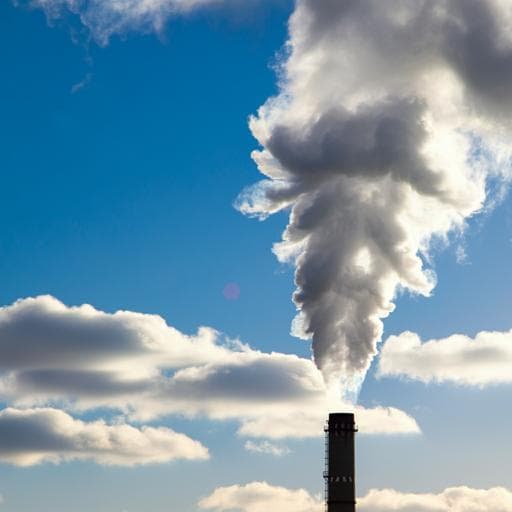
Earth Sciences
Rapid growth and high cloud-forming potential of anthropogenic sulfate aerosol in a thermal power plant plume during COVID lockdown in India
A. Singh, S. S. Raj, et al.
This study, conducted by Aishwarya Singh and colleagues, explores unique insights into aerosol particle formation and their cloud-forming potential during the COVID lockdown in India, revealing the impact of anthropogenic emissions under cleaner conditions.
~3 min • Beginner • English
Introduction
The study addresses how anthropogenic emissions, particularly SO2 from coal-fired power plants, influence aerosol new particle formation (NPF), growth, and cloud condensation nuclei (CCN) under relatively clean atmospheric conditions. The research leverages the COVID-19 lockdown in India (March 25–May 31, 2020), which drastically reduced traffic and industrial emissions, creating conditions to isolate the impact of power sector emissions on aerosol processes. Given that cloud albedo and CCN concentrations are more sensitive to anthropogenic aerosol increases in clean environments, there is a need for measurements rather than solely model-based inferences to quantify aerosol concentrations and properties under such conditions. Chennai experienced substantial reductions in local pollution, while the Neyveli coal-fired power plant (~200 km south) continued operations, providing a quasi-natural experiment to assess the sensitivity of CCN to NPF and growth from SO2 emissions in a tropical coastal environment.
Literature Review
Prior work highlights the strong sensitivity of cloud properties to aerosol concentrations in relatively clean conditions and the large uncertainties in aerosol indirect forcing due to limited observations of preindustrial-like aerosol baselines. Many studies rely on chemistry–climate modeling, with fewer measurements available in heavily polluted regions like India. Previous investigations have shown NPF and growth often dominated by organics across various locations, and power plant plumes can promote sulfate formation via rapid SO2 oxidation, leading to nucleation and growth. Studies also demonstrate that reduced pre-existing aerosol (lower condensation sink) enhances survival and growth of newly formed particles, and that particle number and size dominate CCN variability, with composition and hygroscopicity playing important roles especially at low supersaturations.
Methodology
Observations were made at IIT Madras, Chennai (12.990°N, 80.230°E; 14 m a.s.l.) from 11 April to 6 May 2020 using a common inlet and a temperature-controlled laboratory. Instrumentation and analyses included:
- Aerosol chemical composition (NR-PM1): Quadrupole ACSM (Aerodyne). Species: Org, SO4, NO3, NH4, Cl; 15-min time resolution; vaporizer at ~600 °C; 70 eV electron impact ionization. Calibration with 300 nm ammonium nitrate and sulfate. RIEs: Org 1.4, NH4 5.62, SO4 1.45, NO3 1.1; RF 9.06×10−11; CE 0.5. Note: ACSM insensitive to particles <40–50 nm.
- Particle number size distributions: SMPS (TSI 3082 classifier, 3081 DMA, CPC 3772), aerosol flow 1.0 lpm, sheath 6.0 lpm, size range 9.8–414 nm, 2.5-min resolution. Samples dried to ~20% RH. PM0.5 mass derived from SMPS assuming ρ = 1.1 g cm−3.
- Size-resolved CCN: DMT-CCNC (Model 100) synchronized with SMPS (TSI 3081 DMA + CPC 3776). Particle sizes ~20–350 nm; supersaturations cycled across 0.06–0.8% (Seff via ΔT calibration using ammonium sulfate). Activated fraction NCCN(S,D)/NCN obtained; multiple charge and DMA transfer function corrections applied. D50 and Sc used to retrieve κ (Köhler-based single-parameter method).
- Black carbon (BC): AE-33 Aethalometer at seven wavelengths; flow ~2 lpm; MAC 7.77 m2 g−1 at 880 nm; multiple scattering enhancement C=1.39; leakage parameter Z=0.01; 1-min resolution.
- Transport and source sensitivity: STILT (v2.0) receptor-oriented 120-h back simulations using GDAS 0.5°×0.5° to derive footprints/sensitivities; run per ACSM timestamp. HYSPLIT dispersion modeling (forward) for the Neyveli power plant (11.553°N, 79.441°E) with continuous SO2 emissions (822 kg d−1) from 30–50 m stack; NCEP/NCAR Reanalysis 2.5° input; 24-h forward simulation starting 30 Apr 2020 12:30 UTC.
- Satellite SO2: TROPOMI Level-2 (UV–Vis) regridded to daily lat/lon grid; qa>0.5; converted to Dobson Units; campaign and event-day composites analyzed.
- Meteorology and boundary layer: Local AWS data; back-trajectory analysis of mixed layer depth, trajectory height, and potential temperature to evaluate plume transport and mixing. Equations for condensation sink (CS) and coagulation sink (CoagS) provided in Supplementary Notes.
Key Findings
- Lockdown background: BC remained low (avg 1.5 ± 0.7 µg m−3) with weak diurnal variability, indicating reduced local combustion emissions. Weak SMPS-PM0.5 vs BC correlation (R2=0.18) suggested minor local combustion contributions.
- Event day (1 May 2020): Under southerly winds and low BC (~1.9 ± 0.7 µg m−3), NR-PM1 and SMPS-PM0.5 spiked to ~40 µg m−3; PM2.5 reached ~40–50 µg m−3. Strong SMPS-PM0.5 vs NR-PM1 correlation (R2=0.8; N=92).
- NPF and growth: N10–25 started rising ~08:00 LT, reaching ~10,000 cm−3 within ~20 min; Ntot increased from ~2,500 to ~13,000 cm−3; Dgmd increased from ~20 to ~160 nm by evening, including a new mode appearance around noon. CS was low (~5×10−3 s−1) prior to rapid growth; CoagS two orders lower than CS during event. Growth rates up to ~20 nm h−1 for particles >50 nm (Supplementary Table 4).
- Composition shift: SO4:Org increased ~3× from pre-event (~0.2) to end of growth; sulfate fraction exceeded 50% in NR-PM1 during growth, contrasting with typical organic-dominated growth at this site under business-as-usual conditions.
- Source attribution: Negative association of (BC+Org) with PM1 and positive association of SO4 with PM1; persistent high SO4 after wind shift indicated non-local source. STILT footprints, TROPOMI SO2, HYSPLIT dispersion, and back-trajectories showed strong sensitivity to the Neyveli coal power plant plume from the south/southeast. Meteorological evolution (mixed layer depth changes) consistent with SO2 pickup near source, reduced dispersion en route, and daytime mixing at receptor.
- Mechanisms: Rapid SO2 oxidation to H2SO4 in plume likely drove NPF/growth; heterogeneous SO2 uptake under increasing RH and particle size after ~12:00 LT may have contributed. DMS/MSA pathway considered unlikely (no detectable MSA signal at m/z 79; required DMS would exceed known maxima).
- CCN and hygroscopicity: At Seff=0.15%, κ increased from 0.22–0.25 pre-event to 0.53 during event; D50 ≈ 138 ± 14 nm. At Seff=0.79%, CCN number increased markedly including in the Aitken mode; κ also increased. Sensitivity analyses showed particle number/size as primary modulators of NCCN, with composition (κ) particularly important at low supersaturation: using higher κ alone increased predicted NCCN by 17% (0.79%) and 61% (0.15%); using event size distributions with baseline (lower) κ increased NCCN by 310% (0.79%) and 299% (0.15%). Observed NCCN during growth was 313% (0.79%) and 429% (0.15%) higher than baseline.
- Overall: Sulfate-rich particles rapidly grew into CCN-active sizes with unusually high CCN fractions and κ, demonstrating high cloud-forming potential under clean-background, plume-influenced conditions.
Discussion
The findings demonstrate that under reduced anthropogenic background loading (lockdown), the condensation sink was sufficiently low to enable vigorous NPF and rapid growth when impacted by an SO2-rich plume from a coal-fired power plant. The combined observational and modeling evidence (chemical composition, size distribution evolution, back-trajectories, STILT footprints, TROPOMI SO2, and HYSPLIT dispersion) supports the Neyveli plume as the dominant source of sulfate driving the event. The event reveals that sulfate (via H2SO4 from SO2 oxidation and potentially heterogeneous SO2 uptake under high RH) can dominate growth to CCN-relevant sizes in this tropical coastal environment, contrary to the more common organic-driven growth under polluted conditions. The substantial increases in κ and CCN number concentration, particularly the strong sensitivity at low supersaturation, directly address the study’s goal of quantifying how precursor emissions and aerosol processes modulate CCN under cleaner conditions. These results underscore the climate relevance: in low-background regimes, point-source SO2 emissions can disproportionately enhance CCN and cloud-forming potential, with implications for aerosol–cloud interactions and radiative forcing.
Conclusion
This study provides direct observational evidence that SO2 emissions from a large coal-fired power plant can trigger intense NPF and rapid growth of sulfate-rich particles to CCN-active sizes under relatively clean background conditions. The event in Chennai during the COVID-19 lockdown exhibited unusually high sulfate fractions, rapid increases in particle size (Dgmd to ~160 nm), elevated hygroscopicity (κ up to ~0.53 at low Seff), and large increases in CCN concentrations across supersaturations. The work establishes a measurement-based baseline for tropical India highlighting the strong sensitivity of CCN to point-source SO2 under clean conditions and emphasizes that, in business-as-usual polluted environments, such sulfate-driven growth would likely be suppressed by higher condensation/coagulation sinks. Policy implications include the need to consider plume-driven NPF and growth when designing PM2.5 reduction strategies in coastal clusters. Future research should expand multi-event and multi-site observations, improve chemical speciation at sub-50 nm sizes, quantify heterogeneous SO2 pathways under varying RH, and integrate targeted modeling to refine aerosol–cloud forcing estimates.
Limitations
- Instrumental: ACSM cannot resolve chemical composition for particles <40–50 nm, limiting direct attribution of nucleation-mode composition. Unit mass resolution precluded definitive MSA detection for DMS-source evaluation.
- Case-study nature: Findings are based on a single prominent event under unique lockdown conditions; generalizability across seasons, locations, and non-lockdown conditions requires further study.
- Source apportionment uncertainties: While multiple lines of evidence point to the power plant plume, precise quantitative source attribution and in-plume chemistry remain constrained by model and satellite data resolutions and assumptions.
- Process attribution: H2SO4 condensation alone may not fully explain observed growth rates; contributions from heterogeneous SO2 uptake and other species were inferred but not directly measured.
- Meteorological variability: Boundary layer dynamics and transport pathways can modulate results; detailed vertical profiling was not available.
Related Publications
Explore these studies to deepen your understanding of the subject.







